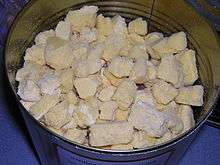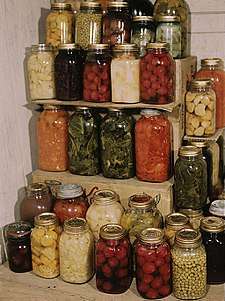Shelf-stable food
Shelf-stable food (sometimes ambient food) is food of a type that can be safely stored at room temperature in a sealed container. This includes foods that would normally be stored refrigerated but which have been processed so that they can be safely stored at room or ambient temperature for a usefully long shelf life.



Various food preservation and packaging techniques are used to extend a food's shelf life. Decreasing the amount of available water in a product, increasing its acidity, or irradiating[1] or otherwise sterilizing the food and then sealing it in an air-tight container are all ways of depriving bacteria of suitable conditions in which to thrive. All of these approaches can extend a food's shelf life, often without unacceptably changing its taste or texture.
For some foods, alternative ingredients can be used. Common oils and fats become rancid relatively quickly if not refrigerated; replacing them with hydrogenated oils delays the onset of rancidity, increasing shelf life. This is a common approach in industrial food production, but recent concerns about health hazards associated with trans fats have led to their strict control in several jurisdictions.[2] Even where trans fats are not prohibited, in many places there are new labeling laws (or rules), which require information to be printed on packages, or to be published elsewhere, about the amount of trans fat contained in certain products.
Packaging
Package sterility and seal integrity are vital for commercially packaged shelf-stable food products. With flexible packaging (plastic films, foils, laminates, etc), the choice of materials and process conditions are an important decision for packaging engineers.[3] [4] [5]
All aspects of food production, package filling and sealing must be tightly controlled and meet regulatory requirements. Uniformity, sterility and other requirements are needed to maintain Good Manufacturing Practices.
Product safety management is vital. A complete Quality Management System must be in place. Verification and validation involves collecting documentary evidence of all aspects of compliance. Quality assurance extends beyond the packaging operations through distribution.
Examples
Canning
Commercial canning involves cooking food and sealing it in sterilized tin cans. Home canning usually involves mason jars and boiling the containers to kill or weaken any remaining bacteria as a form of sterilization.
Retort pouch
Retort pouches involve heat processing the food in sterilized heat-stable flexible packages. This is used for camping food and military field rations.
Ranch dressing
The first shelf-stable formulation of ranch dressing, created in 1983, had a shelf life of 150 days.[6]
Milk products
Pasteurized milk in aseptically processed cartons (Tetra Brik, etc.) is shelf-stable without refrigeration.
Fruit juice
Fruit juice can be processed with proper pasteurization to allow shelf-stable options.[7]
References
- Harris, Gardiner (August 21, 2008). "Irradiation: A safe measure for safer iceberg lettuce and spinach". The New York Times. Retrieved December 30, 2009.
- Leth, Torben (2012). "Denmark's trans fat law". tfX: The campaign against trans fat in foods. Retrieved December 14, 2011.
- Mokowena, K K (2012). "Ethylene Vinyl Alcohol: A Review of Barrier Properties for Packaging Shelf Stable Foods". Critical Reviews in Food Science and Nutrition. 52: 640–650. Retrieved June 21, 2018.
- Koutchma, Tatiana (2010). "PACKAGING EVALUATION FOR HIGH‐PRESSURE HIGH‐TEMPERATURE STERILIZATION OF SHELF‐STABLE FOODS" (PDF). Journal of Food Process Engineering. Retrieved June 14, 2018.
- US4729926A, Koteles, "Packaging material for long-term storage of shelf stable food products and method of making same", published 1988
- Koerner, Brendan I. (August 5, 2005). "America's love-affair with ranch dressing". Slate Magazine. Retrieved December 30, 2009.
- Silva, F V M (2004). "Target Selection in Designing Pasteurization Processes for Shelf-Stable High-Acid Fruit Products". Critical Reviews in Food Science and Nutrition. 40: 353–360. Retrieved June 14, 2018.